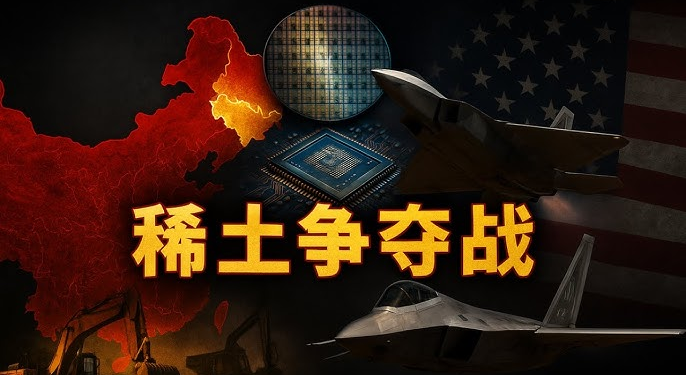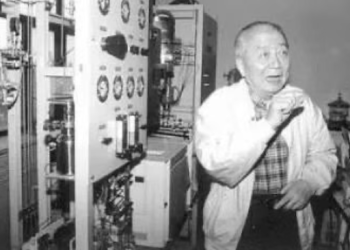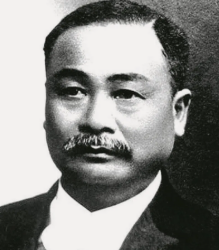une 2025, at the negotiation table in London.
The strategic tug-of-war over critical minerals between China and the United States had already stretched into its seventh hour.
As U.S. Secretary of Commerce Lutnick repeatedly urged China to ease its export restrictions on rare earth elements, the Chinese delegates remained calm and composed. They knew that, in the realm of rare earths, China held all the strong cards.
In fact, the U.S. didn’t have to be in such a weak position—because once, the United States was also a major power in rare earth production.
But it was the U.S. itself that dismantled its own rare earth industry. The Mountain Pass rare earth mine, once a symbol of American dominance, now stands as a living fossil of America’s rare earth dilemma.
One
The discovery of the Mountain Pass rare earth mine was purely accidental.
In 1949, three American geologists arrived at California’s Mountain Pass to explore uranium deposits. They didn’t find uranium—but they stumbled upon rare earth elements instead. Thus, the Mountain Pass mine was born.
Rare earth elements, or REEs, refer to 17 chemical elements: lanthanum, cerium, praseodymium, neodymium, promethium, samarium, europium, gadolinium, terbium, dysprosium, holmium, erbium, thulium, ytterbium, lutetium, scandium, and yttrium.
The first seven elements, with lower atomic weights and densities, are known as light rare earths.
The remaining ten, heavier in atomic mass, are referred to as heavy rare earths.
Mountain Pass is exceptionally rich in resources, with proven reserves of about 4.3 million tons and an average ore grade of over 8%—some zones even reach 15%.
To put this into perspective: China, the world’s rare earth powerhouse, has an average rare earth ore grade of less than 5%.
Soon after the discovery, Molycorp secured mining rights to Mountain Pass. Extraction began in 1952. Initially, the market for rare earths was limited—mostly used in missile components and a few military applications.
For years, the business was bleak. Molycorp nearly gave up. But just before they did, a turning point came.
In 1954, the first practical color television hit the U.S. market. As technology advanced and prices fell, color TVs exploded in popularity by the 1960s.
Coincidentally, color TV screens required rare earths. Europium oxide enhanced red phosphors, and cerium oxide boosted blue tones.
As the only major rare earth producer in the U.S., Mountain Pass rose to prominence. Throughout the 1960s and ’70s, it produced over 20,000 tons of rare earth oxides annually—supplying more than 70% of global demand.
But that wasn’t even Mountain Pass’s peak.
The true revolution came in the 1980s with the invention of neodymium-iron-boron (NdFeB) magnets.
Before that, magnet materials hadn’t changed much in a century—mostly ferrite magnets with magnetic energy densities ranging from 1.1 to 4.0 MGOe.
In 1982, Japanese scientists discovered that adding neodymium to iron and boron created a tetragonal crystal structure with magnetic energy density reaching 50 MGOe.
This discovery meant all magnet-based components could become dramatically smaller—ushering in a technological revolution.
In civilian life, portable audio players replaced bulky boom boxes; cars introduced electric windows, locks, and more.
In military use, NdFeB magnets enabled smaller motors and servos for missile guidance systems and radar components.
Surging demand brought Molycorp enormous profits. By the late 1980s, the U.S. rare earth industry peaked—Mountain Pass supplied over 90% of the world’s rare earths.
From mining to refining to processing, Molycorp owned a complete, integrated supply chain and faced no shortage of customers.
But beneath the boom, a crisis was brewing.
In 1962, the book Silent Spring was published in the U.S., sounding the alarm on industrial pollution. It sold over 2 million copies in the 1960s alone and ignited a national environmental movement.
Environmentalism became politically correct. Campaigns swept across America. Edward Nixon, brother of President Richard Nixon and a Silent Spring enthusiast, played a key role.
In 1970, the U.S. Environmental Protection Agency (EPA) was established, with Edward Nixon championing the “Beautiful America” slogan, advocating for outsourcing polluting industries abroad.
Rare earths came under fire. Though valuable, rare earth ores require separation processes to extract usable elements. For a long time, Molycorp used ion exchange and fractional crystallization—both generating massive wastewater.
Toxic sludge was dumped into a tailings pond, threatening groundwater and sparking community outrage. Edward Nixon personally pressured Molycorp to relocate refining and processing abroad.
In the early 1990s, a rainstorm caused the tailings pond to overflow, releasing waste across the area. Protests and lawsuits ensued. The media demanded that Mountain Pass be shut down.
What about U.S. demand for rare earths? Nixon and other environmentalists shrugged: “Just import from China—what’s the big deal?”
It was a common sentiment at the time, as China’s rare earths were dirt cheap.
In 1985, China began large-scale rare earth exports—4,500 tons in the first year—and kept increasing annually. To boost economic growth, China imposed no export tariffs before 2006, and local governments offered incentives for rare earth mining.
Loose regulations spurred a rare earth boom. In the early 1980s, China produced just 2,500 tons annually. By the early 2000s, output reached 80,000 tons—32 times more. Hundreds of rare earth mines sprang up across the country.
More producers meant fiercer competition—and a race to the bottom in pricing.
According to the State Council’s 2019 report China’s Rare Earths: Situation and Policy, from 1998 to 2005, China earned an average of $420 million per year from rare earth exports, at an annual volume of 46,946.63 tons.
That’s an average price of just $8.98 per kilogram—virtually a giveaway.
With China supplying cheap rare earths and absorbing environmental costs, America was happy to let its own industry die.
Under mounting pressure, Molycorp shut down its refining operations in 1998.
Four years later, Mountain Pass closed entirely.
Thus collapsed America’s once-mighty rare earth empire.
Meanwhile, China rose to become the world’s largest rare earth exporter. Yet it, too, recognized that the low-cost, high-pollution model was unsustainable—and change was inevitable.
Two
In April 2010, the U.S. Government Accountability Office (GAO), an agency under Congress, released a report titled Rare Earth Materials in the Defense Supply Chain. It warned that the United States was heavily reliant on China for rare earth elements—posing a risk to national security—and called for a revival of America’s rare earth industry.
Initially, the report received little attention. That changed in September 2010.
On September 7, 2010, a Chinese and a Japanese vessel collided near the Diaoyu Islands, reigniting diplomatic tensions. Seizing the opportunity to pressure Japan, China tightened its rare earth export controls.
In the second half of 2010, China’s rare earth export volume dropped to around 30,000 tons, far below the 50,000 tons exported during the same period in 2009. This sparked frustration among nations like Japan, the U.S., the U.K., Germany, France, and South Korea.
On October 12, Japan’s ambassador to China, Uichiro Niwa, convened a joint diplomatic push with other Western ambassadors in Beijing to apply pressure on the Chinese government.
But China’s move was entirely justifiable.
All resource-exporting countries seek to avoid merely selling raw materials. China was no exception. Exporting unprocessed rare earths had limited value—developing downstream industries through advanced processing was a strategic imperative.
In response to Western criticism, China’s Ministry of Foreign Affairs firmly stated: “Managing rare earth resources is China’s sovereign right.” The result? Rare earth prices skyrocketed—over fivefold within a year.
This “rare earth crisis” was a wake-up call for the U.S.: If China could choke Japan’s supply chain today, could it do the same to America tomorrow?
The previously ignored GAO report finally gained traction with the Obama administration. Revitalizing the U.S. rare earth industry became a strategic agenda.
Sensing a comeback opportunity, Molycorp lobbied the Obama administration to restart the Mountain Pass mine and proposed the “Phoenix Project.”
The “Phoenix Project” was a massive expansion plan: establishing major processing plants in Arizona and Estonia, and spending hundreds of millions to acquire a rare earth facility in Canada. The total investment reached $1.7 billion—an attempt to rebuild a full rare earth supply chain from mining to magnet production.
In 2013, Mountain Pass generated less than $100 million in revenue. Investing $1.7 billion was an audacious gamble.
But the gamble quickly turned into a dramatic failure.
Ironically, after China implemented its export quota system, the most anxious parties weren’t foreign buyers—but China’s own illegal rare earth miners.
During the unregulated boom years, illegal operators had stockpiled rare earths in hopes of flipping them at high prices. But the quota system shrank the legal market.
Worried about being stuck with worthless inventory, illegal miners rushed to offload stock—often by disguising and exporting it illegally.
Ma Rongzhang, secretary-general of the China Rare Earth Industry Association, revealed: “In 2011, overseas rare earth import statistics were 1.2 times higher than China’s official export numbers. That means smuggling accounted for 120% of legal exports. Smuggling was rampant.”
As a result, instead of rising, international rare earth prices fell—despite China’s tighter controls.
Molycorp was devastated. With already high production costs, it couldn’t compete with falling prices.
Granted, the supply from illegal miners was finite. Prices might have recovered once that supply dried up. But then the Obama administration made a move that completely doomed Molycorp.
The U.S., along with the EU and Japan, filed a complaint against China at the WTO, claiming that its rare earth export controls violated global trade rules.
On August 7, 2014, the WTO’s Appellate Body ruled against China. At the time, China wasn’t yet assertive enough to defy the ruling and was forced to abolish its export quota system in early 2015. Prices plummeted once again.
For example, neodymium prices dropped to just $66 per kilogram—roughly the same as before the “2010 rare earth crisis.” Molycorp’s rare earths had nowhere to go.
The massive investments were in vain. Worse still, Molycorp was now burdened with $1.6 billion in debt. Seeing no path forward, the company filed for bankruptcy, and the Phoenix Project collapsed.
Did Obama not realize his actions were undermining the rare earth industry’s revival?
In fact, he did—but he didn’t care. The primary goal of Obama-era rare earth policy was to pressure China into selling cheap rare earths. Even though the U.S. recognized the strategic importance of rare earths, it failed to approach the issue from a national security standpoint.
The Obama administration offered little policy support for domestic rare earth development, instead relying on market forces.
As former U.S. diplomat Jay Klosdale put it: “The Obama administration’s focus was on using WTO rules to force China to sell rare earths.”
“Reviving the American rare earth industry” was merely a backup plan.
And so, America wasted years of precious time.
Three
In May 2025, rare earths officially became a powerful bargaining chip for China against the United States. While China knew export controls would have an impact, it didn’t expect the effect to be this significant.
Not only did the automotive industries in Japan, Europe, and the U.S. face widespread shutdowns, but even major defense contractors like Lockheed Martin saw their supply lines cut off. Despite some inventory on hand, most could only last for 90 days.
In fact, since the first Trump administration, the U.S. government had recognized the strategic value of rare earths and made a commitment to revive domestic production, particularly at the Mountain Pass mine.
In 2017, after Molycorp filed for bankruptcy, its assets were auctioned off. The Mountain Pass mine was acquired by the MPMO consortium for a bargain price of $20.5 million. Using this acquisition as a foundation, the consortium established a new entity: MP Materials Corp.
MPMO was primarily led by JHL Capital Group, a Chicago-based private investment firm. Its founder and principal, James Litinsky—now the CEO of MP Materials—reportedly holds a personal net worth of approximately $400 million.
James Litinsky’s decision baffled many of his business partners. They couldn’t understand why he would invest in what seemed like an unprofitable venture. But Litinsky was confident that in the era of rising U.S.-China tensions, the U.S. federal government would strongly support domestic rare earth development.
And he was right.
Shortly after acquiring the Mountain Pass mine, the first U.S.-China trade war erupted. Fearing Chinese export controls on rare earths, the Trump administration began offering strong support to revive the domestic rare earth supply chain. Both Trump and Biden took steps far more aggressive than the Obama administration ever did, including:
-
Department of Defense funding to keep Mountain Pass operational
-
Higher tariffs on Chinese rare earths to give Mountain Pass a monopoly in the U.S. market
-
Fast-tracked regulatory approval for rare earth facilities—Mountain Pass’s refinery got approved in just 18 months, instead of the usual 3–5 years
-
Preferential procurement of rare earths for defense projects from Mountain Pass
-
Relaxed environmental standards, including deferred or waived fines and downgraded waste treatment requirements
-
Financial incentives: U.S.-sourced rare earths used in EVs earn manufacturers a 10% cost subsidy, and federal clean energy projects must source 50% of rare earths domestically
In short, the U.S. government used every available tool to jumpstart the rare earth industry.
Yet despite these efforts, America’s rare earth dilemma remains unresolved.
The first issue is profitability.
Rare earths are strategically important but economically small. As of 2023, the global rare earth market was worth just $3.4 billion—with over 70% controlled by China. The U.S. market accounts for only $200–300 million.
In 2024, MP Materials generated just $200 million in revenue but posted a $60 million loss. Since its restart in 2018, it has spent most years in the red and now carries $900 million in debt.
The industry’s small size and low margins make it nearly impossible for MP Materials to invest heavily in R&D or expand downstream capabilities. If the leading U.S. rare earth producer can’t do it, smaller players certainly can’t.
One might wonder—didn’t MP receive lucrative defense contracts?
Actually, defense demand is minimal. About 80% of MP’s revenue comes from exporting rare earth concentrates to China—raw materials still full of impurities, unusable in their current form.
Only after further processing into oxides can rare earths be applied industrially. The remaining 20% of MP’s revenue comes from contracts with Tesla and GM. Defense projects account for at most 10%.
Even Litinsky himself admitted, “Defense demand alone can’t sustain mining operations.”
The second problem is China’s flexible export policies.
In 2021, China merged all rare earth enterprises into China Rare Earth Group to unify planning, production, and exports—eliminating internal competition and illegal smuggling while boosting geopolitical leverage.
This allows Beijing to tighten or loosen controls as needed. Sometimes, China restricts exports to gain bargaining power. Other times, it loosens restrictions to dissuade U.S. efforts to develop its own supply.
For example, just before the June 2025 London negotiations, China eased some civilian rare earth export controls to signal goodwill—or perhaps to weaken American resolve for domestic rare earth independence.
China never intended a total export cutoff. If it were too aggressive, other countries might accelerate alternative sourcing or self-sufficiency efforts, undermining China’s monopoly.
Just look at the semiconductor industry: U.S. sanctions forced China to go all-in on domestic chip development. In ten years, China’s chip self-sufficiency rate grew from under 5% to over 40% by 2024.
Had the U.S. not applied such pressure, most Chinese firms wouldn’t have risked switching to domestic chips of questionable quality and capacity.
By contrast, China’s rare earth policy is intentionally inconsistent, keeping competitors off balance. Even if Washington has the political will, private American firms struggle to follow through—self-reliance comes with enormous costs. If China loosens the tap, U.S. companies naturally choose the cheaper Chinese supply over MP’s more expensive alternatives.
The third issue is technical inferiority.
In rare earth refining, purity is measured in Ns—3N means 99.9%, 4N is 99.99%, and so on. China regularly produces 4N oxides for industry and has achieved 5N–6N in lab settings.
U.S. technology, however, remains stuck at 3N in commercial use. Its only processing facility, built by MP in 2023, can handle just 1,300 tons per year—a tiny output compared to Mountain Pass’s 45,000-ton annual mine production. Most of it still gets shipped to China for processing.
Even worse, the U.S. lacks the heavy rare earths essential for military applications. All of MP’s output is light rare earths. The U.S. has no viable heavy rare earth mines or refining capability.
Meanwhile, the specialized equipment required—electrolyzers, high-precision extractors—is dominated by Chinese suppliers. American firms in this sector disappeared long ago. Even MP’s revived operations rely heavily on Chinese equipment.
If China wants to cut off this supply chain, it wouldn’t be difficult.
The final problem is market demand.
Rebuilding a full rare earth supply chain is admirable. But where are the customers?
Back in the 1980s, Mountain Pass thrived by selling europium and cerium oxides to U.S. television manufacturers. But the last American TV factory closed in 2019. That demand is long gone.
America’s rare earth consumption has plummeted due to deindustrialization. According to the U.S. Geological Survey, consumption fell from 15,000 tons in 2012 to 8,800 tons in 2023—nearly halved.
Obama’s 2009 “reindustrialization” plan failed to reverse this trend. Manufacturing’s share of GDP fell from 13% in 2009 to 10% in 2024.
Even if Litinsky is willing to risk everything to rebuild a domestic supply chain, he can’t find enough buyers to make it viable.
Eventually, like Molycorp, MP Materials could face bankruptcy too.
For now, 80% of its revenue comes from China, selling raw concentrates—not oxides. These unprocessed materials aren’t even competitive in China’s domestic market. MP is stuck in a low-end role, far from realizing America’s rare earth independence.
Four
From the rise, fall, and repeated revivals of the Mountain Pass rare earth mine, we can clearly see the deep-rooted issues plaguing the U.S. rare earth industry.
First, lack of resources is not the problem.
The United States ranks sixth globally in rare earth production. Its allies—Canada, Australia, and even Greenland—possess abundant rare earth reserves ready for extraction and utilization.
Second, the issue is not entirely about technology.
Admittedly, current U.S. rare earth processing capabilities are lagging. But if the government were to lead a determined, large-scale technological push, many of the existing bottlenecks could be overcome.
Third, policy support has not been lacking.
Both the Biden and Trump administrations have rolled out generous support policies—from subsidies and procurement guarantees to environmental leniency and fast-track approvals.
So why has the U.S. rare earth industry continued to struggle?
Because capital, by its very nature, chases short-term profits. Investors gravitate toward the most lucrative, lowest-risk segments of the value chain—such as raw material extraction or financial speculation—while steering clear of high-risk, long-term commitments like advanced refining technology or full industrial integration.
Because environmental politics and deindustrialization have become twin shackles. Even when the path forward is clear, progress is often undermined by political correctness and anti-industrial sentiment.
Ironically, these same issues also exist in China. But China has, through strong central coordination and long-term strategic planning, managed to mitigate the worst effects. The Chinese government can steer capital, align incentives, and enforce industrial discipline.
The United States, however, remains bound by free-market logic and ideological rigidity—unable to act decisively or plan far ahead.
That is why, despite its resources, allies, and policies, America’s rare earth ambitions remain mired in uncertainty.
The road to a revitalized U.S. rare earth supply chain is riddled with obstacles—and its future remains bleak.











